Karashi-ae dressing is a Japanese mustard dressing which is made with mustard, soy sauce and dashi stock. It has a kick of hot mustard but is quite light as it does not use oil at all unlike most Western salad dressings. I used broccolini today but you can use other vegetables.
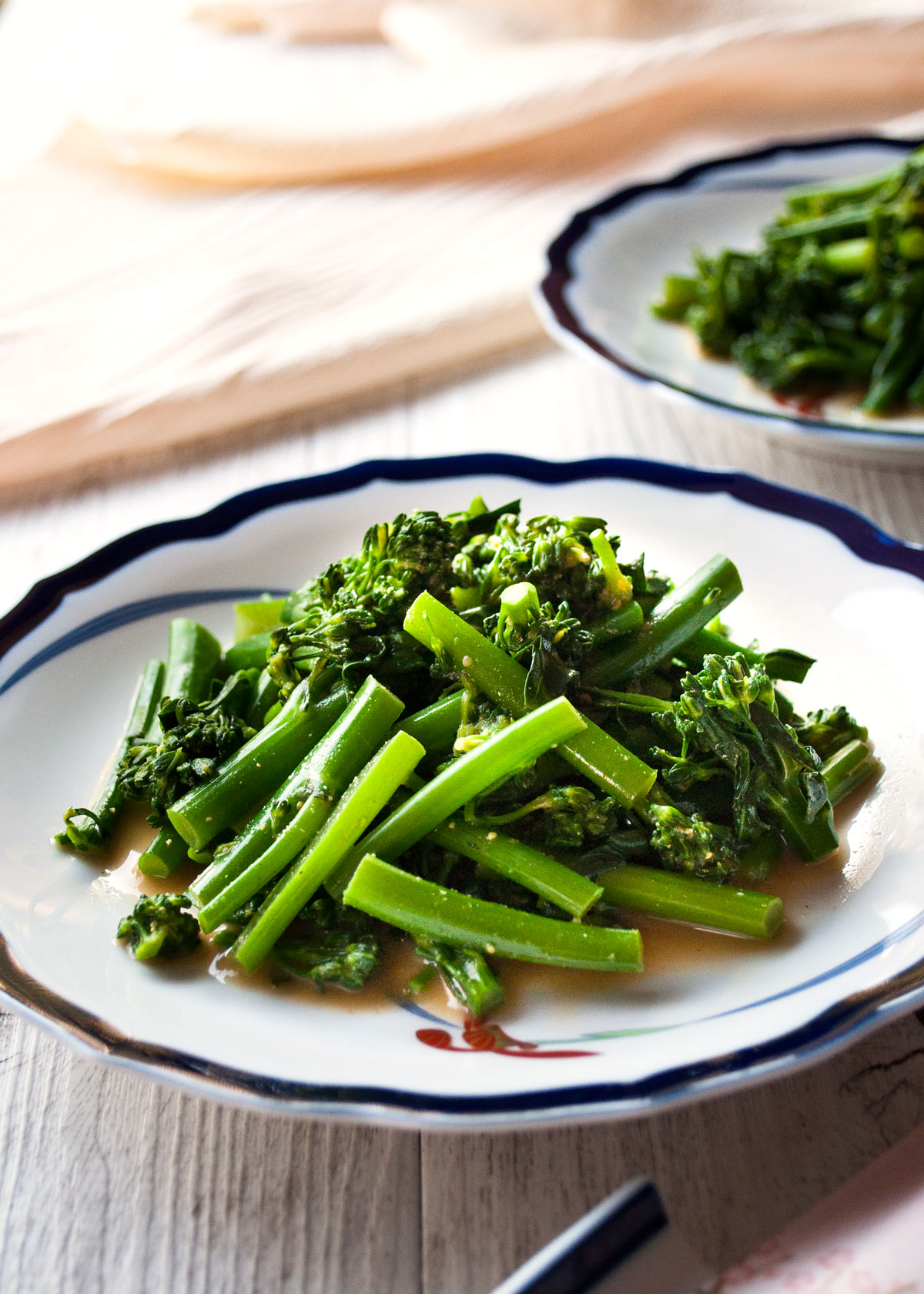
Karashi-ae (辛子和え) means “dressed in mustard dressing” and is one of many dishes referred to as aemono dishes which means “food which are dressed or seasoned”. Karashi (辛子) means mustard so when a dish is dressed with a dressing made with mustard, it is called “karashi-ae”, ie. karashi + ae (和え, referring to aemono dishes).
Applying this same rule to other dishes, if it is a sesame based dressing, then it is called goma-ae (胡麻和え), being goma (胡麻 sesame) + ae.
There are many other aemono in Japanese dishes and the following are the common aemono.
- Karashi-ae (辛子和え) – Japanese mustard based
- Goma-ae (胡麻和え) – sesame based
- Miso-ae (味噌和え) – miso based
- Sumiso-ae (酢味噌和え) – vinegar and miso based
- Ume-ae (梅和え) – pickled sour plum based
- Shira-ae (白和え) – tofu based
- Unohana-ae (卯の花和え) – soy pulp (soybean curd refuse) based
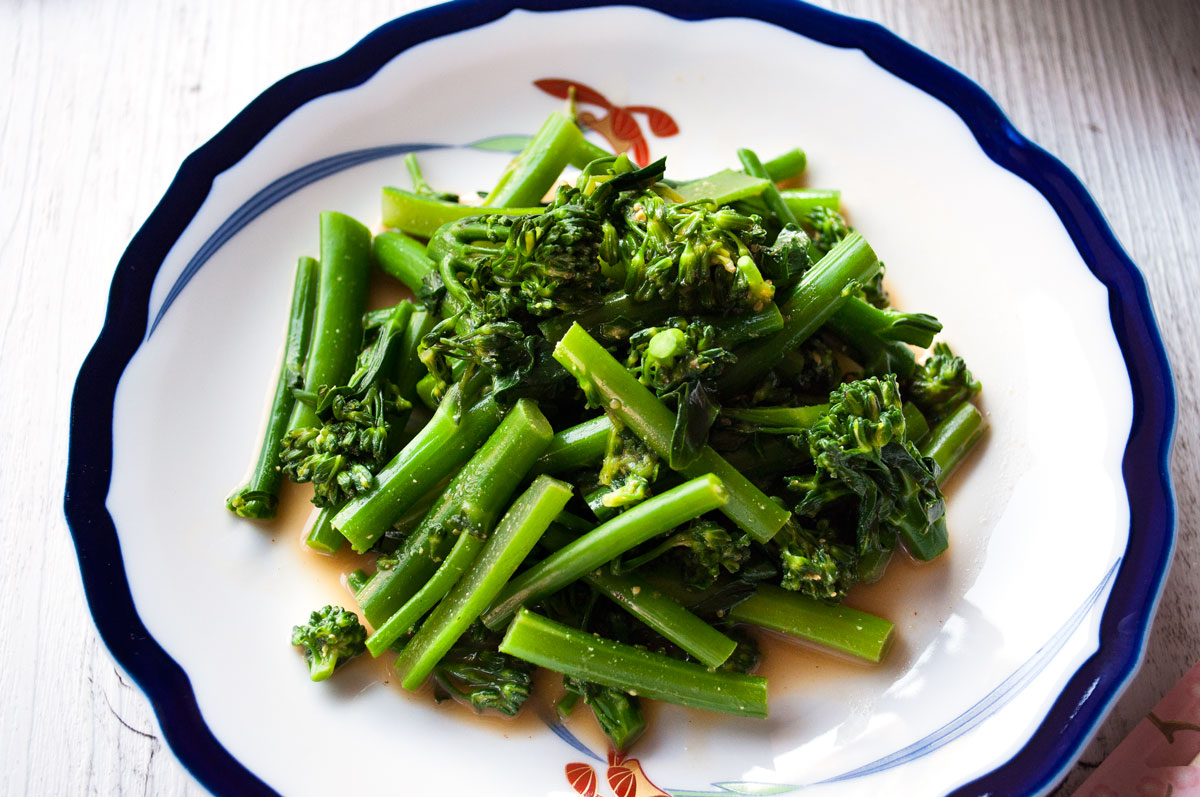
I wanted to use few stems of broccolini for my next post “Sakamushi Fish”. When I went to the nearby Harris Farms Market, broccolini was on sale so I bought few bunches. Since I only used a couple of stems for the next post, I decided to make karashi-ae with broccolini.
Karashi (辛子, Japanese mustard)
In Japan, Japanese mustard is called karashi while Western style mustards are generically called “masutardo” (マスタード) to distinguish them from the Japanese mustard. The taste is quite different compared to Western style mustards. It is quite hot and I think that it is twice as hot as Hot English mustard. It is so sharp that when you eat even a small amount of karashi, it gets to your noze! But only momentarily.
Karashi is just plain powdered mustard seeds. When I was young, karashi was only sold as powder in a tiny tin. You simply mix the powder and water/ lukewarm water to make karashi paste. But these days karashi in a paste form is sold in a tube like the photo below.
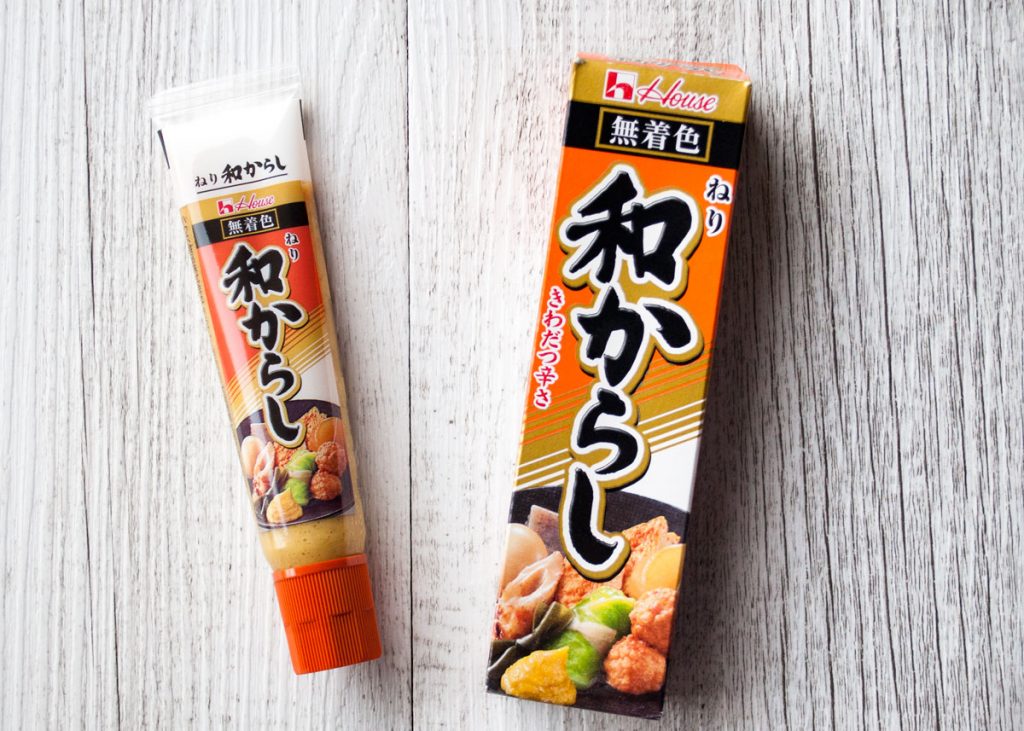 Karashi is the household item in Japan and used in many dishes not only as condiments but also to add extra kick to the dressings. You can buy karashi at Japanese/Asian grocery stores.
Karashi is the household item in Japan and used in many dishes not only as condiments but also to add extra kick to the dressings. You can buy karashi at Japanese/Asian grocery stores.
If you cannot find karashi, you can use Hot English mustard instead. The flavour of the dressing would be slightly different but it still tastes good. American mustard and Dijon mustard are not suited for this dish.
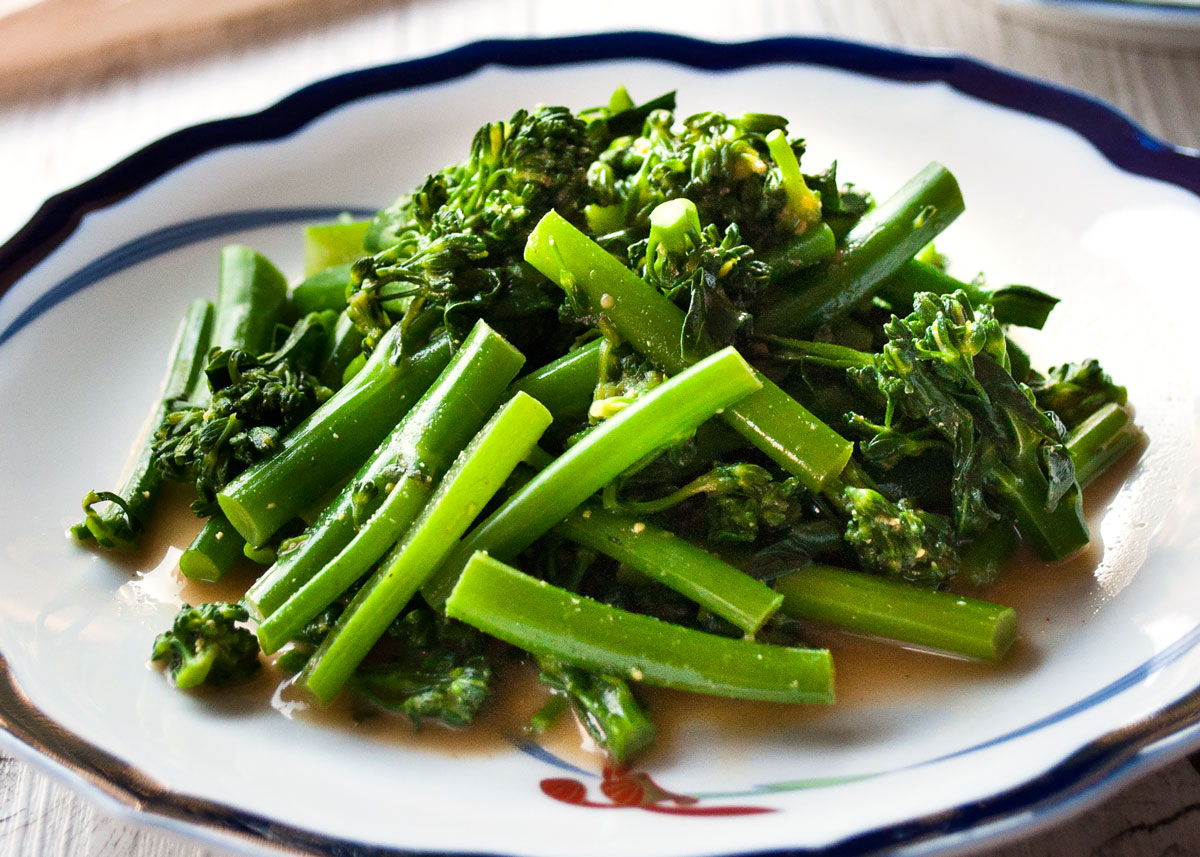
In Japan, if you mention karashi-ae, most people will think of nanohana ( 菜の花, grapeseed or field mustard) as the vegetable the dressing is used for. It is one of the spring vegetables and when nanohana starts appearing at the stores, people know that spring has come.
I have not seen field mustard in Sydney so I substitute it with other green vegetables. Instead of broccolini, you could use spinach, green beans, Chinese choy sum, Chinese broccoli.
There is no oil in the dressing, just mustard, dashi and soy sauce. It is so simple to make and flavoursome. When you eat it, you will get a sharp kick of hot mustard momentarily but that is what makes this salad so unique.
I served karashi-ae on two plates as salad for individual. But this can be served as appetiser in which case, you can have up to 6 servings. I have tiny bowls which can be used to serve sides like this. They are called kobachi (小鉢). It would not have much use when you cook Western style meals but I find that small bowls like these are handy to have when you have large number of people and need to spread nibbles like peanuts in various places on the table.
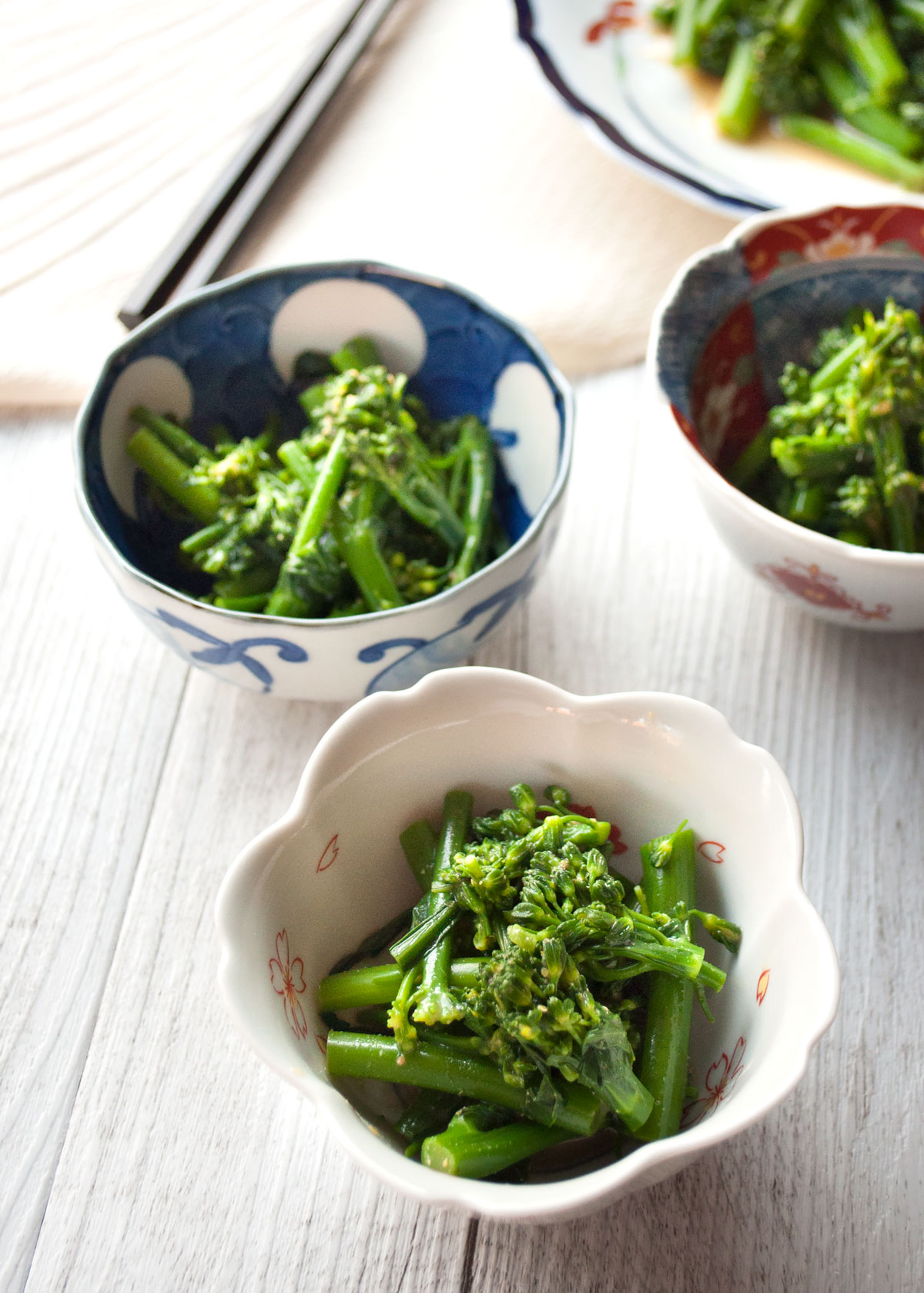
The diameter of these kobach is about 9cm/3½”. When I bought them, they came with a set of 6 with different shapes and patterns and I thought they were quite cute. You might have noticed in my previous posts but I even use the top left kobachi for sauce and dressings.
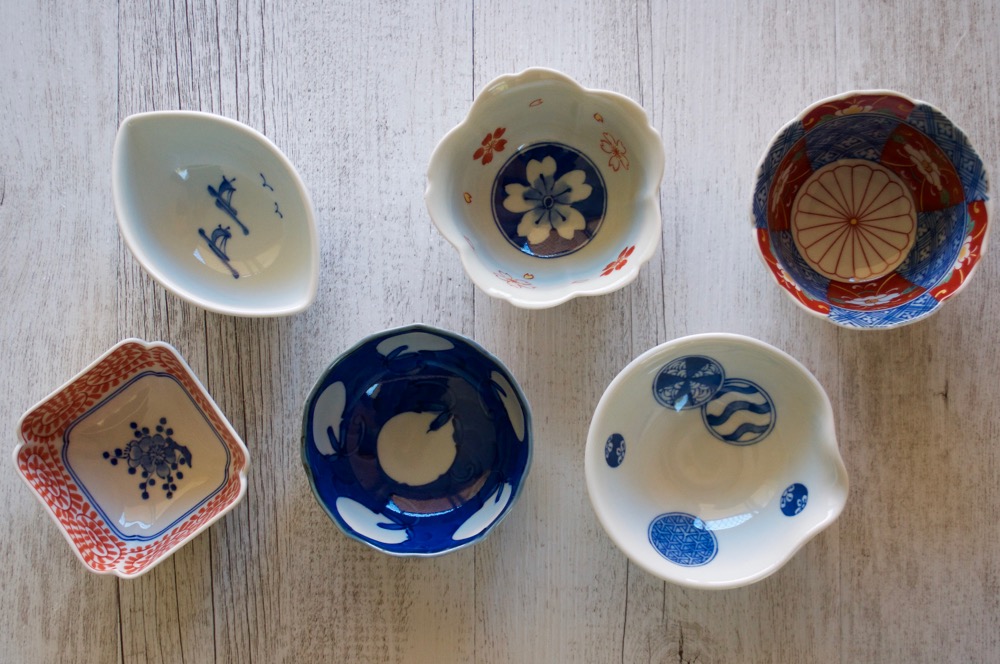
Yumiko![]()
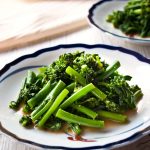
- 200g (0.4lb) broccolini (Note 1)
- 3 tbsp dashi stock (Note 2)
- 3 tsp karashi mustard (Note 3)
- 3 tsp soy sauce
-
Mix the Dressing ingredients in a large bowl. Ensure that mustard is completely dissolved with no lumps.
-
Boil sufficient water in a large pot with a pinch of salt. Add broccolini to the pot and boil for 2-3 minutes until stems are tender.
-
Drain and run under cold water to quickly cool them down.
-
Cut the broccolini into 5cm (2"). Squeeze as much water out of the broccolini as possible and put them in the bowl with the dressing.
-
Mix well ensuring that all the broccolini pieces are coated with the mustard dressing.
-
Serve in a large bowl/plates as salad or individual small bowls if serving as appetiser.
1. You can substitute broccolini with spinach, green beans, Chinese choy sum, Chinese broccoli, or even cabbage.
2. Please refer to Home Style Japanese Dashi Stock for how to make dashi stock. If you are a vegetarian, please use konbu dashi stock.
3. Karashi is different from the Western style mustard and it does not contain acidity nor spices. It is quite hot but the kick from the spice does not last at all unlike chillies. You can buy a tube of karashi mustard at Asina/Japanese grocery stores. But if you cannot find it, you can substitute with hot English mustard or hot mustard. American mustard and Dijon mustard are not suited.
I have powdered dashi stock, will that work? If so, do you want it converted to liquid form before mixing it with the karashi?
Hi Audrey, you can substitute it with powdered dashi stock. You need to convert it to liquid form and use the same quantity of liquid dashi per the recipe. It should taste good!
Will Coleman’s dry mustard powder work?
Hi Audrey, yes, Coleman’s dry mustard ois fine.
Loving your recipes particularly the detail of the word origin and characters. You are a beautiful writer. Thank you.
Thanks you so much, Malinda!
Hi I always look forward to getting your lovely recipes.
One thing I would ask you to do could you please make the wording in your recipes darker as like many people my eye site is not what it use to be and I find it hard to read your recipes with the light print. Regards Peter.🙋
Hi Peter, I am sorry but I did not realise it was a problem for some people. I will look into it.
Konnichiwa Yumiko-san! Again, a lovely simple dish! I have a Chinese dry mustard powder that you mix with water and it is quite pungent, but very good! Would that be an acceptable substitute? Your plating is perfect!
Yes, Chinese dry mustard powder should work.